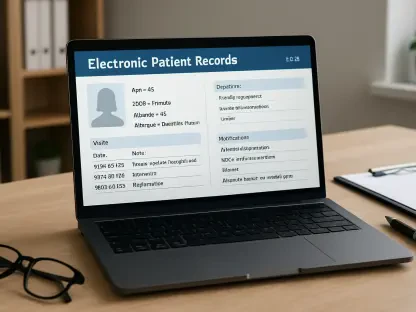Overview of the Healthcare and Medicaid Landscape
The U.S. healthcare system stands at a critical juncture, grappling with systemic challenges that impact millions of low-income individuals who rely on Medicaid as a vital safety net for medical coverage. This program, serving over 70 million Americans, acts as a cornerstone for providing care to those who might otherwise go without, yet it faces unprecedented pressures from policy shifts threatening to reshape its foundation. Amid rising healthcare costs and disparities in access, Medicaid’s role has never been more essential. The stakes are high for patients, providers, and policymakers navigating this complex terrain.
Medicaid’s significance extends beyond individual beneficiaries to influence the broader healthcare industry, where stakeholders are increasingly turning to technology to address inefficiencies. Hospitals and clinics face mounting administrative burdens, while patients often struggle with convoluted enrollment processes. Recent legislative changes have further complicated this landscape, with substantial cuts to federal funding raising concerns about reduced access to care. These shifts could strain provider finances, as uncompensated care costs are projected to rise, prompting an urgent need for innovative solutions to bridge emerging gaps.
The intersection of policy and technology is becoming a defining factor in how the industry adapts to change. With digital tools gaining traction, there is potential to streamline processes and mitigate some of the fallout from restrictive reforms. However, the scale of recent policy adjustments, which aim to reduce federal healthcare spending, poses a significant test for whether technology can keep pace with the evolving needs of vulnerable populations and the providers who serve them.
Cedar’s Strategic Response with Cedar Cover
Addressing Enrollment and Retention Challenges
In response to mounting barriers in Medicaid access, Cedar has introduced Cedar Cover, a digital tool designed to simplify the often daunting enrollment and management process for beneficiaries. This platform offers a suite of features, including eligibility screening to identify potential enrollees, reminders for meeting work requirements and renewal deadlines, and assistance with claims denials and medication cost support. By focusing on these pain points, the tool aims to prevent coverage loss due to administrative oversights or procedural complexities.
Cedar Cover also integrates seamlessly with major electronic health record systems like Epic, ensuring that healthcare providers can access and utilize the platform within their existing workflows. Through partnerships with entities such as Fortuna Health, the tool leverages state-specific data to tailor its guidance, making it a customized resource for both patients and providers. This integration is poised to reduce the time and effort spent on navigating state-by-state variations in Medicaid rules, offering a more cohesive approach to coverage management.
The emphasis on user-friendly support underscores a broader goal of empowering individuals to maintain their benefits amid tightening regulations. By automating reminders and providing actionable insights, Cedar Cover seeks to address systemic issues that disproportionately affect low-income populations, ensuring that bureaucratic hurdles do not stand in the way of essential healthcare services.
Early Adoption and Market Impact
Unveiled at the HLTH conference this year, Cedar Cover has already garnered attention from key players in the healthcare sector, with early adoption by prominent health systems such as Novant Health and Baystate Health. This initial rollout signals confidence in the tool’s ability to address pressing challenges faced by providers and patients alike. The conference served as a platform to showcase how the solution could transform administrative processes at a time when efficiency is critical.
Feedback from these early adopters points to a reduction in the administrative load, allowing staff to focus more on patient care rather than paperwork. Moreover, the tool’s design suggests strong scalability potential, with the capacity to adapt to diverse healthcare environments across different states. Indicators of success include anecdotal reports of fewer coverage lapses among enrolled patients, a metric that could prove vital as policy changes threaten to increase uninsured rates.
As more health systems explore implementation, the market impact of Cedar Cover may extend beyond immediate users to influence industry standards for managing Medicaid enrollment. If successful, this could pave the way for broader adoption of digital interventions, reshaping how healthcare organizations tackle the fallout from legislative reforms and positioning Cedar as a leader in this niche.
Challenges Posed by Historic Medicaid Cuts
The recent wave of Medicaid cuts has introduced significant financial and operational hurdles for healthcare providers nationwide. With federal funding slashed, hospitals anticipate a sharp rise in uncompensated care costs as more patients lose coverage and become unable to pay for services. This financial strain could force some facilities to reduce services or cut staff, directly impacting the quality and availability of care in underserved communities.
Beyond the economic toll, the social ramifications of these cuts are profound, particularly for low-income populations already facing barriers to healthcare. Coverage loss, driven by stringent eligibility criteria and complex bureaucratic processes, risks exacerbating health disparities. Work requirements, in particular, add a layer of difficulty, as many beneficiaries struggle to meet or document compliance, leading to unintended disenrollment even when they qualify for benefits.
Technological interventions like Cedar Cover offer a potential lifeline by addressing some of these administrative challenges, but they cannot fully offset the broader impact of reduced funding. Providers and policymakers must also consider complementary strategies, such as enhanced outreach programs or advocacy for revised policies, to cushion the blow of these cuts. The multifaceted nature of this crisis demands a coordinated response to protect both patient access and provider stability.
Regulatory Shifts and the One Big Beautiful Bill Act
The passage of the One Big Beautiful Bill Act marks a seismic shift in Medicaid policy, with a staggering $1 trillion reduction in federal healthcare spending planned over the next decade. This legislation, signed into law recently, targets Medicaid as a primary area for savings, introducing controversial work requirements that mandate beneficiaries demonstrate engagement in work, education, or volunteer activities to retain coverage. Such measures aim to reallocate resources but have ignited fierce debate over their implications.
Supporters of the act argue that it promotes fiscal responsibility by ensuring that public programs serve only those in genuine need, potentially reducing government expenditure. Critics, however, caution that these changes could lead to massive coverage loss, with bureaucratic obstacles and stringent rules disproportionately affecting vulnerable groups. Studies from earlier state-level experiments with similar requirements suggest that many lose benefits without corresponding gains in employment, highlighting the risk of widening healthcare disparities.
Compliance with evolving eligibility criteria and reporting mandates under this act presents an additional burden for both beneficiaries and providers. Tools like Cedar Cover are becoming essential in navigating this regulatory maze, offering automated support to ensure adherence to new rules. As the landscape continues to shift, the need for adaptive solutions that balance compliance with accessibility remains a pressing concern for all stakeholders.
Future Outlook for Medicaid and Healthcare Technology
Looking ahead, the long-term implications of current Medicaid policy changes are sobering, with projections from the Congressional Budget Office estimating an additional 10 million uninsured individuals by 2034. This trend threatens to undermine healthcare access for the most vulnerable, while placing immense pressure on providers struggling to maintain financial viability. Patient outcomes, particularly in chronic disease management, could deteriorate as barriers to care multiply over the coming years.
Technology stands as a critical mitigating factor in this uncertain environment, with innovations like Cedar Cover demonstrating how digital tools can alleviate some of the administrative and access challenges posed by policy shifts. The growing integration of such platforms into healthcare systems points to a future where data-driven solutions play a central role in stabilizing enrollment and retention processes. Partnerships between tech firms and health organizations are likely to expand, fostering more tailored approaches to regional needs.
Emerging trends also suggest a broader digital transformation within the Medicaid space, with potential disruptions or stabilizing effects depending on economic and regulatory developments from 2025 to 2030. Increased investment in user-centric design and interoperability could enhance the efficacy of these tools, while policy uncertainty may spur further innovation. The interplay between technology and legislation will undoubtedly shape the trajectory of healthcare delivery for low-income populations in the years ahead.
Conclusion and Implications for the Industry
Reflecting on the developments surrounding Medicaid policy and technological innovation, it has become evident that the intersection of these forces creates both formidable challenges and unique opportunities. The historic cuts embedded in recent legislation have cast a long shadow over healthcare access, with providers and patients alike bracing for the repercussions of reduced funding and stricter eligibility rules. Cedar’s introduction of a targeted digital tool has emerged as a beacon of adaptability, illustrating the potential for technology to address systemic gaps.
Moving forward, stakeholders need to prioritize scalable solutions that can safeguard vulnerable populations while supporting overburdened healthcare systems. Investment in digital platforms that streamline enrollment and compliance processes has proven to be a practical step, as demonstrated by early successes in specific health systems. Additionally, advocacy for balanced policies that align fiscal objectives with equitable care access has become imperative to prevent further erosion of the safety net.
The path ahead demands a collaborative effort to harness innovation and influence policy reform. Health leaders and tech developers must continue exploring partnerships that amplify the reach of tools designed for real-world impact. By focusing on actionable strategies and maintaining a commitment to protecting the underserved, the industry can navigate the turbulence of this era with resilience and purpose.









